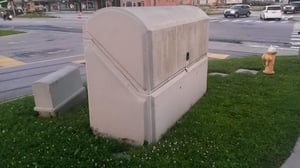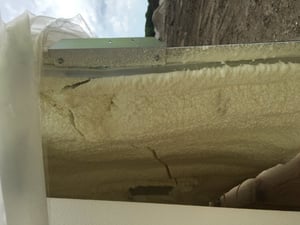
This may come as a surprise, but there aren’t many options on the market for pump covers protecting against weather, vandals and animals.
One popular solution is inexpensive fiberglass enclosures with a clamshell design, providing easy access to the pump for quick visual inspections.
If the occasional visual inspection is all that’s needed — and no service or repairs need to be made to the pump — a fiberglass clamshell pump cover would probably do the trick. In the real world, though, we know that there’s far more to factor in when it comes to protecting sensitive pump equipment.
What’s more, while a clamshell fiberglass cover might have been sufficient for mild climates in the past, changes in weather patterns and increasingly extreme weather events throughout the country should give you pause when you're considering a pump cover solution.
We haven’t been shy about our feelings toward fiberglass in the past. Today, there just aren’t any compelling reasons why you should consider fiberglass options over aluminum in any use case.
Fiberglass vs. Aluminum Pump Covers: A Quick Review
Many pump covers need to be modified or altered to meet custom specifications. Because fiberglass enclosures are brittle they require specialized equipment and skilled, trained eyes and hands to fit to these specs — all while requiring ideal weather conditions.
Once installed, fiberglass will fade, crack and deteriorate over time, simply from normal exposure to ultraviolet light. Relative to aluminum, it's fragile (like a sea shell), less protected, and is subject to shattering.
On the other hand, aluminum is easy to work with; adding windows, panels, louvers, vents and other accessories is relatively simple. The aluminum pump cover can be mounted to a pump skid, and piping penetrations for customization during installation can be easily performed.
Marine-grade aluminum is ideal in all environments and can protect against normal weather patterns for up to and, in some cases, in excess of 30 years. Our partnership with PAC-CLAD means that the color of your pump cover is baked into the aluminum, resisting fading and color loss.
Let's Talk Clamshell Pump Covers

There are other key differences between clamshell pump enclosures and modular pump covers.
-
The most obvious difference between clamshell fiberglass pump covers and aluminum enclosures is ease of access. If pump equipment does need maintenance, an enclosure with removable modular panels will always work better to protect against the elements. With a removable roof, pumps can be lifted entirely in and out of enclosures.
-
Clamshell enclosures typically ship pre-assembled. Modular enclosures ship flat, include stainless steel hinges and are assembled onsite.
-
This might be unexpected, but a fiberglass enclosure is often heavier than a similarly sized aluminum pump cover. A buyer may be looking at a fiberglass enclosure as a value play, but there's a stealth cost in paying more for shipping because the fiberglass cover takes up more space per square foot and also weighs more.
-
Because clamshell enclosures are typically made of fiberglass, you'll have to worry about shipping damage in transit. Sometimes pump covers arrive cracked.
-
Another major distinction between clamshell enclosures and Safe-T-Cover is the insulation. We use polyisocyanurate panels, which are laminated to a glass fiber-reinforced facer on each side. Most clamshells have spray-in insulation, which has a rough consistency that can trap dirt and other debris and, again, is prone to cracking and damage.
-
Modular enclosures built like ours mean that any panel can be a removable panel or door, and that equipment can even be mounted to a hinged panel for quick access. You can't exactly get away with mounting a control unit to the side of a clamshell pump cover.
Get What You Really Need
At first, a clamshell fiberglass pump cover may sound like a cost effective solution to your equipment protection problem. You probably just want to get that decision out of the way, right?
The savvy buyer needs to take a long-term view when it comes to shelters for protecting pump systems. That equipment is likely to be in place for years or decades. In order to properly service it and conduct any needed repairs, you need better access and features than a clamshell fiberglass enclosure provides.
Additionally, a pump cover should fit the equipment perfectly, which means custom elements or penetrations may be needed. Note that some varieties of fiberglass enclosures may not allow for accessories like an exhaust fan to be installed.
Finally, in order to save money now and in the long run, buyers should look to purchase the most durable option, one that will maintain its looks and provide superior protection throughout its entire lifecycle. Options like standard enclosures or custom pump enclosures are built to offer safety and protection needs for years to come.
Ready to get started? Download our free checklist below.





